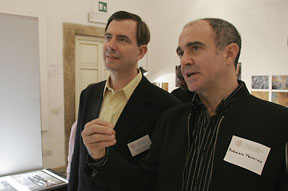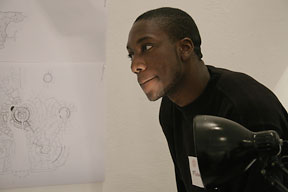Alumni, faculty reflect on two decades of cultural immersion and interdisciplinary study
By Daniel Aloi

ROME -- Cornell in Rome alumni, faculty and current students alike say the program provides an exceptional experience and opportunity to learn and grow, personally and as artists, urban planners and architects.
"There are immediate effects and delayed effects -- you can see the students being transformed before your very eyes," said Jeffrey Blanchard, professor of architectural history and the program's academic coordinator since 1994, following 20th anniversary events held March 24-26. "And through the years there has been a never-ending flow of visitors coming back to tell you how much it has meant to them."
With high participation among students in Cornell's College of Architecture, Art and Planning (AAP), the program enrolls 50 to 60 students each semester.
"It's essentially part of the curriculum; they plan which semester they want to come," said Jill Lerner '75, B.Arch. '76, a Cornell trustee on the AAP advisory council. Many Cornell alumni at her architectural firm, Kohn Pedersen Fox in New York, "say the Rome program was the very best part of their experience," she said. "It stands as the real jewel in the crown, to be replicated by other programs."

Cornell students from outside the college and visiting non-Cornell students also are encouraged to apply.
Curricula in Rome include urban studies, architecture, studio art, art and architectural history, photography, drawing, and courses in Italian culture, language and cinema.
"To my mind there's a very happy correspondence between these disciplines at Cornell," Blanchard said. "One of the things we've discussed is how to create richer interdisciplinary programs in Rome."
Students live together in apartments close to their classrooms and studios in Palazzo Lazzaroni, a 17th-century building in the historic heart of Rome. They can regularly be found working on their projects late into the night (much as they do in Ithaca). All regularly visit sites in Rome from the Vatican to the Colosseum; many of the courses are taught on site.
"They're definitely well-prepared, although here, they are in a totally different dimension -- they have to face history," said Jan Gadeyne, now in his 10th year as an adjunct professor of architectural history. "It's my job to guide them through it. I start my course by saying 'Rome is a prisoner of its past.'"
Andrea Strongwater '70, an artist also on the advisory council, said, "I think it's very important to an artist. It's completely self-directed; no one tells you what to do."
Students are exposed to more than masterpieces of art, historic architecture and the workings of a city both ancient and modern -- by living there, they become part of "the substance of the city and its cultural and intellectual life," Blanchard said.

Blanchard came to Rome 29 years ago on a fellowship to the American Academy and joined Cornell in Rome in 1988. "Jeffrey knows every piece of art in this city, and everyone; and is a walking encyclopedia -- the students really love him," Strongwater said.
As a lasting record of the experience, students have their sketchbooks and journals to refer to for inspiration long after leaving Rome.
"I flipped through all of them before coming here," said architect Bryant Lu '98 of Hong Kong, who studied in Rome in 1995. "Photographs will fade, but sketchbooks are an even more important part of it. They're so personal."
Sites throughout Italy provide further study, on one-day and overnight trips to gardens, archaeological sites, museums and important contemporary art collections in cities and towns including Tivoli, Milan, Florence, Venice and Naples. A group of current students recently ventured north to Aosta in the Italian Alps, Bologna and Turin. Other programs include guest lectures by leading practitioners and an Italian film series.
Cornell in Rome is one of 123 member institutions in Italy of the Association of American Colleges and Universities.
"It's an exceptionally well-run program," Lerner said. "One of the best things about this is it takes [AAP students] and puts them all together, for all that intellectual cross-fertilization to take place."
AAP Dean Mohsen Mostafavi mentioned the college's international reach to weekend attendees, and the possibility of establishing a "European center" for the college.
"This year, we have architecture students in Buenos Aires, in Mexico City, in Puerto Rico, in Lisbon, in Nairobi," in addition to New York City and Rome, he said.

The anniversary events included a panel discussion on contemporary Italian architecture in conjunction with the new AAP book "Italy Now?" and a public lecture by architect Zaha Hadid.
"It's a program that's always been characterized by a high degree of academic seriousness," Blanchard said.
Current planning students are studying socioeconomic factors in three diverse Roman neighborhoods: Ostiense, Flaminio and Magliana Vecchia.
"They spend most of their time out in the field, talking to citizen groups and local governments," said Professor Gregory Smith, whose students also consider globalization and international development issues. Many planning students in Rome also intern with United Nations agencies such as the World Food Program and the Food and Agricultural Organization.
Student architects in the Rome program this semester have produced a portfolio of design proposals for a modern museum of contemporary architecture and culture, in harmony with its historic surroundings.
"We had to analyze a component of the city, and from there, people took interpretations of their project," said Geraldine Diaz-Velez '07, whose project emphasizes music and film production. "You work on an urban scale and try to define the project; now we will go into some detail."
Visiting alumni also provided valuable insight in their critiques of student work.
"It was great to have all these alumni here -- all these architects, to have them come in the middle [of the semester] and take what they said in critiques," Diaz-Velez said. "We now have more to work on."
AAP associate dean and professor of art Stanley Taft, who heads the college's Rome Steering Committee, said, "We are interested in developing the program even further. Rome itself has become much more dynamic as a city. For me to see the contemporary art world flourishing in the city makes me believe that this is exactly the place to be."
Media Contact
Get Cornell news delivered right to your inbox.
Subscribe